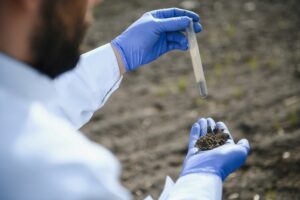Soil testing in the USA helps determine the soil’s chemical, physical, and biological properties. Soil testing is crucial for modern agriculture because it offers valuable insights into the presence of major soil nutrients like nitrogen, potassium, and phosphorous, minor elements like Calcium, magnesium, and sulfur, and trace elements like zinc, molybdenum, iron, and copper. Soil testing also helps to determine the pH level of the soil. Farmers and agronomists can make better decisions about crops, nutrients, fertilizers, or other essential factors impacting crop productivity with this information.
How Can a Farmer Decide the Nutrient Content of a Field with a soil test?
To use a soil test to know the nutrient content of the field, the farmer has to collect samples from different locations throughout the field. These samples will be tested and analyzed. The detailed reports will indicate the nutrient levels in the soil. These include the elements like phosphorus, nitrogen, and potassium.

Source: Freepik
What are the Five Crucial Things that A Soil Test will Tell You?
The soil sample report will offer details about the following five things to the farmers:
- Soil pH – The report shows the alkalinity or acidity of the soil.
- Nutrient levels—Soil testing in the USA shows the levels of crucial nutrients like phosphorus, nitrogen, potassium, and other micronutrients.
- Organic matter content—The soil testing report will show the amount of organic matter present in the soil, which influences its fertility.
- Soil texture – It shows the soil composition, whether sandy, clay, or loamy.
- Recommendations—Depending on the analysis, the report will also offer recommendations for amending the soil. These include fertilizer types, lime, and application rates.
Good soil can be identified by its balanced texture, capability to retain enough moisture, presence of organic matter, and presence of active soil life like earthworms. These indicators suggest a fertile and well-structured soil that supports healthy plant growth.
Clay soil has the finest texture. The clay particles are the smallest among the three primary soil types, which also include sand and silt. Clay soil has a smooth and sticky texture when wet and can hold moisture and nutrients. However, because of its compact nature, it can lead to drainage and make it tough for plants’ roots to penetrate.
When it comes to soil sample testing, it is better to have a moist one instead of completely dry soil. It is better to collect samples when the soil is at field capacity. Simply put, when the soil has enough moisture to hold together when squeezed but not overly saturated, it is the ideal time to collect samples. This will allow better mixing and soil sample analysis, ensuring more accurate pH levels and nutrient results.
Level up Your Soil Test:
While soil testing provides a good understanding of the levels of nutrients in your fields’ soil, there can be gaps in the information given to you. This is because samples are taken at varying ratios, but do not offer details as to what is happening in between those specific soil sample locations. This is where technology can help to fill those gaps. Utilizing sensors such as gamma radiation spectrometry can provide more in-depth analysis over and above what a soil sample test can offer. Combining methods can give farmers more of a comprehensive understanding to ensure that the best management decisions are being made.
What Do Weeds Tell You About Your Soil?
Weeds are excellent indicators of soil condition. They offer valuable insights. Different types of weeds thrive in specific soil conditions. Judging the condition of the weeds, you shall learn about nutrient deficiencies, pH balances, and compaction. Observing the types and abundance of weeds within a field, the farmers can know about the underlying soil issues. Weeds also indicate poor quality soil or improper soil management practices. Analyzing the weed presence and its characteristics can help farmers customize their soil management strategies and address the underlying soil health concerns.
In Conclusion:
The primary purpose of soil testing in the USA is to get information on the following:
- How to address nutrient deficiencies
- Improve soil management practices
Soil testing during a farming preseason planning enables a deeper understanding of the soil nutrient levels and overall health. A soil test will help identify the potential problems in the ground, including nutrient deficiencies and pH imbalances, before planting. Also, soil testing in the USA is a cost-effective way to stay informed on fertilization and make other crop management decisions. Using the data, farmers can ensure long-term productivity. Soil testing in the USA empowers you to have complete and accurate details of the soil. We are here to help you with that. Visit – https://soiloptix.com/ to get your soil tested.
